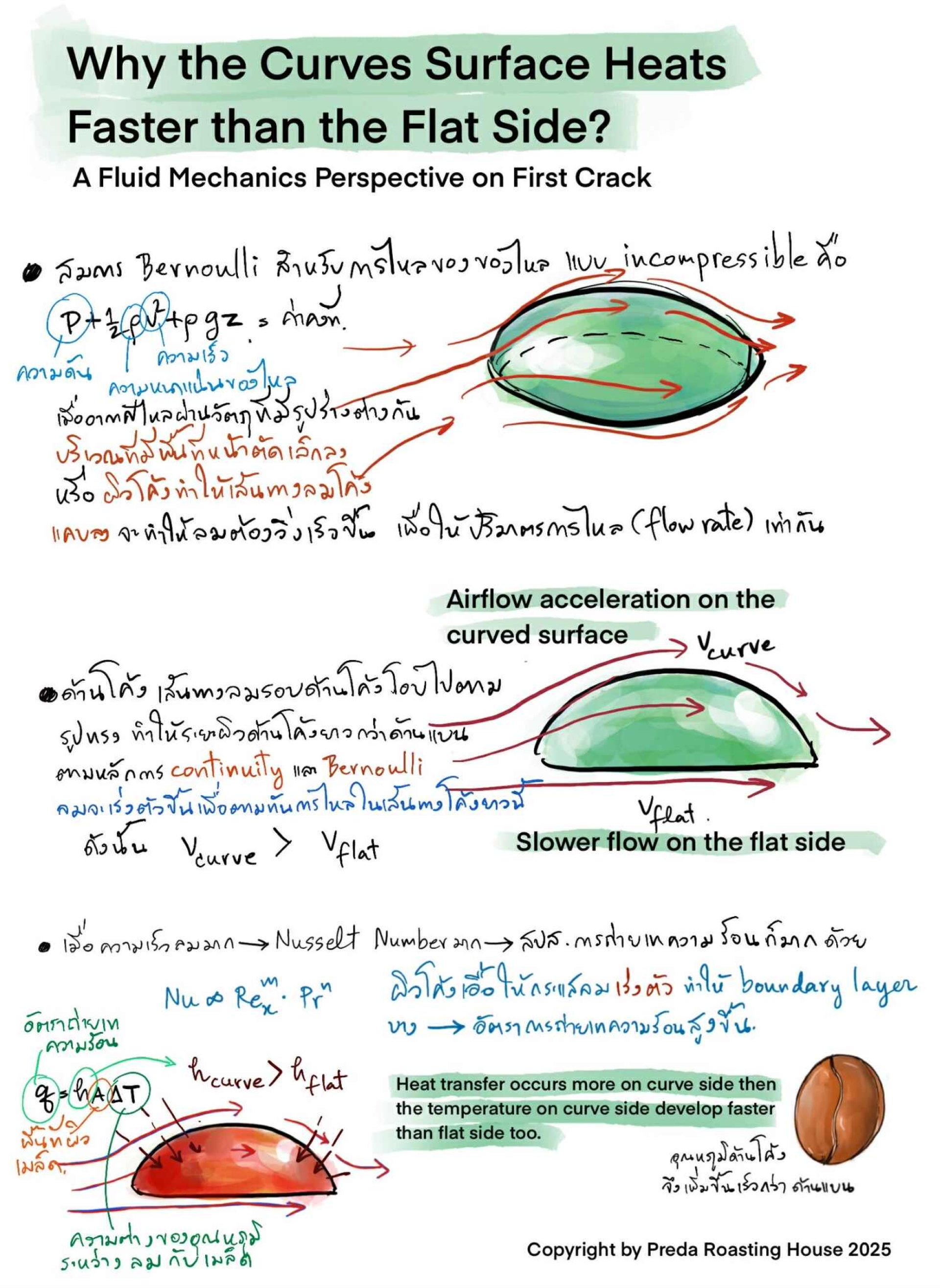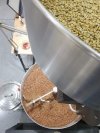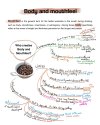Why the Curved Surface Heats Faster than the Flat Side?
Last updated: 15 Aug 2025
631 Views

Why the Curved Surface Heats Faster than the Flat Side?
[From a Fluid Mechanics Perspective on First Crack]
The other day, I was talking with a younger friend about the physical mechanisms behind the First Crackwhere it comes from and how it happens. Since she used to work in the aviation field, I brought up an analogy about airflow hitting coffee beans, causing changes in air pressure and velocitymuch like how airflow interacts with an airplane wing. After explaining, I realized it might be useful to write it down in a way that paints a clearer picture.
Its the hot airflow striking the beans elliptical shape that causes heat transfer on the curved side and the flat side to happen at different rates. This difference in heating becomes the root cause of uneven expansion between the two areas, which eventually leads to what we call the First Crack.
Science may involve many interconnected variables, which can seem complicated, but I believe we can understand it clearly enough.
Today, well explain it using Fluid Mechanics and Thermodynamicssubjects every mechanical, energy, or chemical engineering student must learn. Trust me, its fun once you get it.
1. Bernoullis Principle and Airflow Around the Bean
According to Bernoullis Principle and the Continuity Equation, when airflow passes over a curved surface, it is forced into a narrower path. This accelerates the airflow and reduces the pressure. Higher airflow velocity directly increases the heat transfer coefficient (h), allowing the curved side to absorb heat faster than other surfaces.
(See the Bernoulli equation for incompressible flow in the accompanying diagram.)
When air flows past an object of varying shapes, areas with a smaller cross-sectional pathor a curved profile that narrows the flowforce the air to move faster to maintain the same volumetric flow rate. Thats why air passing over the curved side of the bean naturally moves faster than over the flat side.
2. Understanding the Boundary Layer
What is a boundary layer?
Imagine a thin layer of air stuck to an objects surface as airflow moves past it. This is the boundary layer, and its thickness directly affects both heat transfer and flow resistance.
On the curved surface: As airflow encounters the curve, it is squeezed and accelerates early in its path.
Higher velocity air molecules have more energy thinner boundary layer
Thinner boundary layer heat transfers more easily higher heat transfer coefficient (h)
On the flat surface: Air is not accelerated as much.
As it flows further, the boundary layer thickens due to momentum exchange between the slow-moving air near the surface and the faster air above it
Thicker boundary layer harder for heat to transfer lower h
Summary:
Curved surface faster airflow thinner boundary layer faster heating
Flat surface slower airflow thicker boundary layer slower heating
3. Why the Curved Side Expands First
When beans approach the expansion phase (just before First Crack), the curved side heats faster. I ran some temperature simulationsletting AI crunch numbers based on different assumptionsand in every case, the flat sides temperature lagged behind the curved side.
This difference in heating rate creates a temperature gradient (ΔT) inside the bean. The curved side expands first, while the flat side remains slightly cooler. This imbalance stores mechanical energy inside the cell wall in the form of tensile and shear stress.
4. Shear Stress and First Crack Initiation
Once the expansion difference becomes large enough, the cell wall structure can no longer withstand the shear stress caused by the ΔT. Points where the structure is thinner and exposed to higher heat or stronger airflowsuch as the tips of the ellipse or the groove near the curved sideoften become the starting point of the First Crack.
In drum roasters with axial airflow (beans spinning lengthwise in the same direction as drum rotation), airflow hitting the bean tips accelerates heating in these spots.
Thats why we often see coffee beans cracking along the flat side near the tip of the ovalthis area is thinner and experiences the highest shear stress.
5. Arabica vs. Robusta
Heres an extra analysis: Arabica beans tend to have a more pronounced oval shape, which increases ΔT inside the bean, leading to higher shear stress and a louder First Crack. Robusta beans, being rounder, have a lower ΔT and less shear stress, resulting in a softer crack.
This hasnt been formally researched yet, but Ill put it forward as a working theory. In short, the rounder shape of Robusta makes it harder for us roasters to hear the crack.
Conclusion
Ive written about this topic before, referencing both international and Thai research (see link below the article), but this time I wanted to tell the story differentlyso we can see all aspects of how First Crack happens. With a clearer understanding, uncertainties fade away.
Experienced roasters know that beans develop differently on the curved and flat sides, and naturally, the flavor from each side will also differ.
Once we understand the cause and effect, our precision improves
and our coffee becomes more beautiful.
Thank you,
Kee, 14 Aug 2025
Related article: "Why Does the First Crack Usually Appear on the Flat Side of the Bean?"
[From a Fluid Mechanics Perspective on First Crack]
The other day, I was talking with a younger friend about the physical mechanisms behind the First Crackwhere it comes from and how it happens. Since she used to work in the aviation field, I brought up an analogy about airflow hitting coffee beans, causing changes in air pressure and velocitymuch like how airflow interacts with an airplane wing. After explaining, I realized it might be useful to write it down in a way that paints a clearer picture.
Its the hot airflow striking the beans elliptical shape that causes heat transfer on the curved side and the flat side to happen at different rates. This difference in heating becomes the root cause of uneven expansion between the two areas, which eventually leads to what we call the First Crack.
Science may involve many interconnected variables, which can seem complicated, but I believe we can understand it clearly enough.
Today, well explain it using Fluid Mechanics and Thermodynamicssubjects every mechanical, energy, or chemical engineering student must learn. Trust me, its fun once you get it.
1. Bernoullis Principle and Airflow Around the Bean
According to Bernoullis Principle and the Continuity Equation, when airflow passes over a curved surface, it is forced into a narrower path. This accelerates the airflow and reduces the pressure. Higher airflow velocity directly increases the heat transfer coefficient (h), allowing the curved side to absorb heat faster than other surfaces.
(See the Bernoulli equation for incompressible flow in the accompanying diagram.)
When air flows past an object of varying shapes, areas with a smaller cross-sectional pathor a curved profile that narrows the flowforce the air to move faster to maintain the same volumetric flow rate. Thats why air passing over the curved side of the bean naturally moves faster than over the flat side.
2. Understanding the Boundary Layer
What is a boundary layer?
Imagine a thin layer of air stuck to an objects surface as airflow moves past it. This is the boundary layer, and its thickness directly affects both heat transfer and flow resistance.
On the curved surface: As airflow encounters the curve, it is squeezed and accelerates early in its path.
Higher velocity air molecules have more energy thinner boundary layer
Thinner boundary layer heat transfers more easily higher heat transfer coefficient (h)
On the flat surface: Air is not accelerated as much.
As it flows further, the boundary layer thickens due to momentum exchange between the slow-moving air near the surface and the faster air above it
Thicker boundary layer harder for heat to transfer lower h
Summary:
Curved surface faster airflow thinner boundary layer faster heating
Flat surface slower airflow thicker boundary layer slower heating
3. Why the Curved Side Expands First
When beans approach the expansion phase (just before First Crack), the curved side heats faster. I ran some temperature simulationsletting AI crunch numbers based on different assumptionsand in every case, the flat sides temperature lagged behind the curved side.
This difference in heating rate creates a temperature gradient (ΔT) inside the bean. The curved side expands first, while the flat side remains slightly cooler. This imbalance stores mechanical energy inside the cell wall in the form of tensile and shear stress.
4. Shear Stress and First Crack Initiation
Once the expansion difference becomes large enough, the cell wall structure can no longer withstand the shear stress caused by the ΔT. Points where the structure is thinner and exposed to higher heat or stronger airflowsuch as the tips of the ellipse or the groove near the curved sideoften become the starting point of the First Crack.
In drum roasters with axial airflow (beans spinning lengthwise in the same direction as drum rotation), airflow hitting the bean tips accelerates heating in these spots.
Thats why we often see coffee beans cracking along the flat side near the tip of the ovalthis area is thinner and experiences the highest shear stress.
5. Arabica vs. Robusta
Heres an extra analysis: Arabica beans tend to have a more pronounced oval shape, which increases ΔT inside the bean, leading to higher shear stress and a louder First Crack. Robusta beans, being rounder, have a lower ΔT and less shear stress, resulting in a softer crack.
This hasnt been formally researched yet, but Ill put it forward as a working theory. In short, the rounder shape of Robusta makes it harder for us roasters to hear the crack.
Conclusion
Ive written about this topic before, referencing both international and Thai research (see link below the article), but this time I wanted to tell the story differentlyso we can see all aspects of how First Crack happens. With a clearer understanding, uncertainties fade away.
Experienced roasters know that beans develop differently on the curved and flat sides, and naturally, the flavor from each side will also differ.
Once we understand the cause and effect, our precision improves
and our coffee becomes more beautiful.
Thank you,
Kee, 14 Aug 2025
Related article: "Why Does the First Crack Usually Appear on the Flat Side of the Bean?"
Related Content
One common challenge many specialty-coffee roasters encounter when roasting dry-process coffee is the appearance of overly strong fermented aromasoften leaning toward ripe or overly alcoholic fruit.
At Preeda Roasterys roasting class, students get to taste both their own roasts and their classmates.
มีคำถามมาว่าจะคั่วโรบัสต้ายังไงให้อร่อย? เพราะหลายคนพยายามคั่วโรบัสต้าให้ฟรุ้งฟริ้งยังไงก็ไม่สำเร็จ กลับจะไปทาง earthy ไม่ค่อยมีรสมีชาติ
บางคนบ่นว่ากลิ่นสาบแรงไปเลยก็มี




